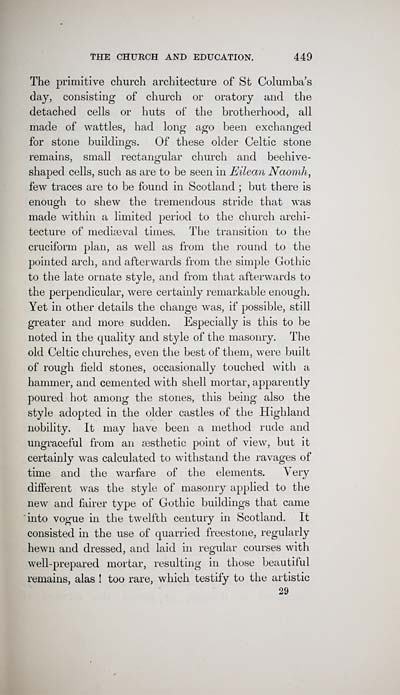Matheson Collection > Clan Donald > Volume 1
(521)
Download files
Complete book:
Individual page:
Thumbnail gallery: Grid view | List view

THE CHURCH AND EDUCATION. 449
The primitive church architecture of St Columba's
day, consisting of church or oratory and the
detached cells or huts of the brotherhood, all
made of wattles, had long ago been exchanged
for stone buildings. Of these older Celtic stone
remains, small rectangular church and beehive-
shaped cells, such as are to be seen in Eilean Naomh,
few traces are to be found in Scotland ; but there is
enough to shew the tremendous stride that was
made within a limited period to the church archi-
tecture of mediaeval times. The transition to the
cruciform plan, as well as from the round to the
pointed arch, and afterwards from the simple Gothic
to the late ornate style, and from that afterwards to
the perpendicular, were certainly remarkable enough.
Yet in other details the change was, if possible, still
greater and more sudden. Especially is this to be
noted in the quality and st3de of the masonry. The
old Celtic churches, even the best of them, were built
of rough field stones, occasionally touched with a
hammer, and cemented with shell mortar, apparently
poured hot among the stones, this being also the
style adopted in the older castles of the Highland
nobility. It may have been a method rude and
ungraceful from an aesthetic point of view, but it
certainly was calculated to withstand the ravages of
time and the warfare of the elements. Very
different was the style of masonry applied to the
new and fairer type of Gothic buildings that came
into vogue in the twelfth century in Scotland. It
consisted in the use of quarried freestone, regularly
hewn and dressed, and laid in regular courses with
well-prepared mortar, resulting in those beautiful
remains, alas ! too rare, which testify to the artistic
29
The primitive church architecture of St Columba's
day, consisting of church or oratory and the
detached cells or huts of the brotherhood, all
made of wattles, had long ago been exchanged
for stone buildings. Of these older Celtic stone
remains, small rectangular church and beehive-
shaped cells, such as are to be seen in Eilean Naomh,
few traces are to be found in Scotland ; but there is
enough to shew the tremendous stride that was
made within a limited period to the church archi-
tecture of mediaeval times. The transition to the
cruciform plan, as well as from the round to the
pointed arch, and afterwards from the simple Gothic
to the late ornate style, and from that afterwards to
the perpendicular, were certainly remarkable enough.
Yet in other details the change was, if possible, still
greater and more sudden. Especially is this to be
noted in the quality and st3de of the masonry. The
old Celtic churches, even the best of them, were built
of rough field stones, occasionally touched with a
hammer, and cemented with shell mortar, apparently
poured hot among the stones, this being also the
style adopted in the older castles of the Highland
nobility. It may have been a method rude and
ungraceful from an aesthetic point of view, but it
certainly was calculated to withstand the ravages of
time and the warfare of the elements. Very
different was the style of masonry applied to the
new and fairer type of Gothic buildings that came
into vogue in the twelfth century in Scotland. It
consisted in the use of quarried freestone, regularly
hewn and dressed, and laid in regular courses with
well-prepared mortar, resulting in those beautiful
remains, alas ! too rare, which testify to the artistic
29
Set display mode to: Large image | Transcription
Images and transcriptions on this page, including medium image downloads, may be used under the Creative Commons Attribution 4.0 International Licence unless otherwise stated. ![]()
| Early Gaelic Book Collections > Matheson Collection > Clan Donald > Volume 1 > (521) |
|---|
| Permanent URL | https://digital.nls.uk/76685897 |
|---|
| Description | Volume 1. |
|---|---|
| Attribution and copyright: |
|
| Description | Genealogy. (Library only has two volumes of three at this shelf mark.) |
|---|---|
| Shelfmark | Mat.165-6 |
| Additional NLS resources: |
| Description | Items from a collection of 170 volumes relating to Gaelic matters. Mainly philological works in the Celtic and some non-Celtic languages. Some books extensively annotated by Angus Matheson, the first Professor of Celtic at Glasgow University. |
|---|
| Description | Selected items from five 'Special and Named Printed Collections'. Includes books in Gaelic and other Celtic languages, works about the Gaels, their languages, literature, culture and history. |
|---|

